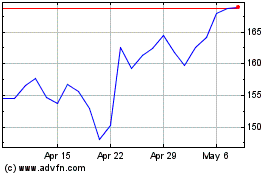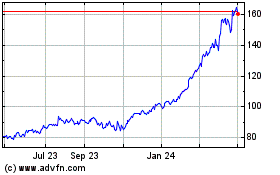By Thomas Gryta, Dana Mattioli and David Benoit
As its strategic review stretches into a ninth month, General
Electric Co. is exploring a public offering for one of its
divisions and discussing hybrid deals with public companies to
combine assets, according to people familiar with the matter.
Rather than straight asset sales, the hybrid deals would leave
GE shareholders with stakes in multiple public companies. The
possibilities include spinning off a division to investors or
combining a division with a smaller public company in a way that
avoids a big tax bill. Such moves would give the industrial
conglomerate and its shareholders a chance to participate in the
turnaround of struggling businesses rather than risk selling at
inopportune times.
GE Transportation could be a model, according to some of the
people. GE is now unlikely to sell the business and is preparing
for an initial public offering or spinoff of the division, which
makes diesel freight locomotives, some of the people said. The unit
could be merged with another firm that would leave GE investors in
control of a new public company, one person said.
GE, whose share price has tumbled by more than half over the
last 12 months, will be facing questions about its portfolio review
in coming weeks. The company reports first-quarter results on April
20 and hosts its annual shareholder meeting the following week.
Chairman and CEO John Flannery is the headliner at a major
industrial conference on May 23.
"The pressure on GE to announce some sort of breakup is very
high," analyst Scott Davis of Melius Research wrote in a note to
clients last month. While he said asset sales are going slower than
investors expected, Mr. Davis expects spinoffs to be more
likely.
In October, Mr. Flannery promised to sell $20 billion worth of
assets. So far GE has announced a handful of deals totaling less
than $4 billion. The company's century-old GE Lighting division has
been on the auction block for more than a year. In January, Mr.
Flannery said he was considering separate structures for the core
divisions -- health care, aviation and power -- in what would
amount to a breakup of the industrial giant.
Rather than breaking off units to make smaller companies, GE is
considering deals that would build bigger businesses that are
better positioned, the people familiar with the matter said. They
point to Baker Hughes, an oil-field services company that is
majority owned by GE, and the Dow- DuPont deal that combined two
firms with plans to eventually split into three different
companies.
GE is exploring the structural changes to narrow its focus,
improve its profits and better deploy its limited resources, Mr.
Flannery says. Using spinoffs and retaining stakes, however, won't
necessarily translate to success if the businesses themselves don't
turn around and that can take time, analysts say. Others are
concerned that parting with too many industrial assets could leave
the company too exposed to the liabilities and debts that remain
its GE Capital arm.
"GE should have sufficient liquidity through '20 to meet its
projected cash outflow commitments," said Bank of America Merrill
Lynch analyst Andrew Obin in a note to clients this week. He added,
"there is little room for error from the execution standpoint or
another sizable charge at GE Capital."
GE has a mixed record on deal making, and simplifying the
conglomerate may take years. Investors have different views over
whether management is moving fast enough. Some say uncertainty
about strategy and future structure has depressed the stock price.
Other investors argue GE should avoid a fire sale since it doesn't
face a liquidity crunch.
People close to Mr. Flannery say he is being methodical and
measured in his approach to making changes. There is a sense of
urgency in the process, but GE also has access to cash and most of
its major businesses are performing well, these people said.
GE has a history of divesting businesses in phases -- it sold
its media business, NBCUniversal, to Comcast Corp. in several
steps. Its consumer-finance unit, Synchrony Financial, went public
in 2014 and GE sold its last shares in late 2015.
GE combined its Oil & Gas division with Baker Hughes in July
2017 to form a new public company with a former GE executive as
CEO. GE said in November it would look to exit Baker Hughes but
changed course in February, saying it wouldn't try to sell its
majority stake before 2019.
GE has examined different options for the transportation
division since last fall but hasn't been able to find a buyer,
according to one person familiar with the matter. Weak demand has
hit locomotive sales, but a public offering could allow GE
investors to benefit if the market turns around.
The Wall Street Journal previously reported GE's effort to exit
the business could be complicated because an outright sale could
trigger a big tax hit. GE has owned the business for more than a
century.
The transportation unit, which had sales of $4.2 billion last
year, is one of the company's smaller divisions. It has an
enterprise value of about $7 billion, according to Bank of America
Merrill Lynch. In the freight rail market, it competes primarily
with Electro-Motive Diesel, a unit of Caterpillar Inc.
GE is also reviewing what to do with what remains of its
financial-services business, GE Capital. The company in 2015 sold
most of the unit, which was once one of the biggest U.S. lenders.
But some pieces remain and have caused problems. Shortfalls in a
long-term care insurance business recently forced GE Capital to set
aside $15 billion in reserves over seven years.
GE is further paring the finance business and is even
considering selling the entire GE Capital portfolio, according to
the people familiar with the matter. Although GE Capital has about
$157 billion in assets, some analysts say it has zero equity value.
They say the liabilities and uncertainties might require GE to
write a check to complete such a deal. The unit had about $31
billion in cash and $95 billion in debt as of Dec. 31.
Write to Thomas Gryta at thomas.gryta@wsj.com, Dana Mattioli at
dana.mattioli@wsj.com and David Benoit at david.benoit@wsj.com
(END) Dow Jones Newswires
April 12, 2018 13:29 ET (17:29 GMT)
Copyright (c) 2018 Dow Jones & Company, Inc.
GE Aerospace (NYSE:GE)
Historical Stock Chart
From Mar 2024 to Apr 2024

GE Aerospace (NYSE:GE)
Historical Stock Chart
From Apr 2023 to Apr 2024
